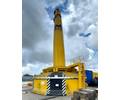
Statoil Petroleum recently completed a North Sea inline isolation in order to facilitate the tie-in of its Valemon platform to its Huldra-Heimdal pipeline. The tie-in will require 27km (16mi) of pipe to be laid. Statoil chose SmartPlug isolation technology, by T.D. Williamson (TDW), to safely isolate the line for 89 days during the operation.
The tie-in necessitated a fairly complicated isolation operation, for which Statoil turned to TDW. The SmartPlug isolation method provides a proven, double block and monitor isolation that would prevent flooding during the tie-in operation.
“The DNV GL-certified SmartPlug isolation method allowed production from Huldra to continue for an additional five months,” says Atle Halvorsen, TDW Project Manager. The line was isolated for 89 days at an average isolation pressure of 1218psi (84 bar) and hydrotested at 2523psi (174 bar).
In addition to the production gains, this isolation was distinctive for its extensive use of Global System for Mobile Communications (GSM) monitoring. GSM delivered several tangible benefits to Statoil:
The SmartPlug tool and standard commissioning pigs were fitted with SmartTrack transponders that allowed monitoring of the tools through a wide range of communication setups, including cabled, acoustic, radio link, and GSM-based logging.
The SmartPlug tool was monitored by the crew every hour during the tie-in activities and when the pipeline was hydrotested. Six different measurements were taken: the high pressure side of the tool (HP), low pressure side (LP), annulus pressure (AP) between the two isolation plug modules, internal pipeline temperature (Internal), outside temperature (OT), and remote transceiver temperature (RTT), which monitors the temperature on the seabed.
The greatest advantage of the GSM link was that it allowed for accurate monitoring to continue during the long periods of inactivity, a month or more, between certain phases of the tie-in. Without the GSM link, a one- or two-man crew would have been required during these periods, thus increasing Statoil’s cost for the operation. According to Halvorsen, Huldra is an unmanned platform and monitoring by crew alone would have necessitated deployment of a full supporting platform crew over the course of the operation.
“The sophisticated monitoring techniques developed to complement the SmartPlug isolation technology allowed us to complete a very complicated job in the minimum time necessary and at the lowest cost to Statoil,” says Halvorsen.
Image from TDW



